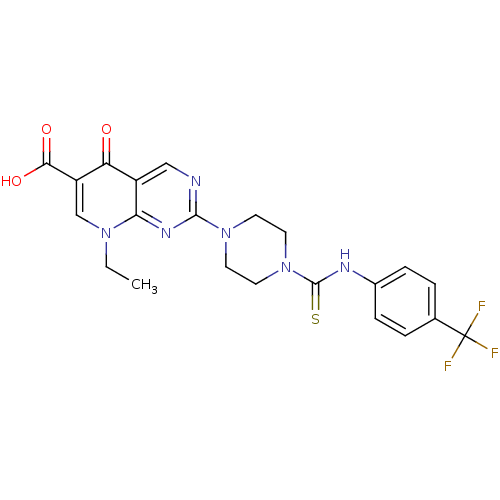 Found 4 Enz. Inhib. hit(s) with Target = 'Ectonucleotide pyrophosphatase/phosphodiesterase family member 2' and Ligand = 'BDBM50300208'
Found 4 Enz. Inhib. hit(s) with Target = 'Ectonucleotide pyrophosphatase/phosphodiesterase family member 2' and Ligand = 'BDBM50300208' TargetEctonucleotide pyrophosphatase/phosphodiesterase family member 2(Homo sapiens (Human))
The University Of Memphis
Curated by ChEMBL
The University Of Memphis
Curated by ChEMBL
Affinity DataKi: 1.32E+4nMAssay Description:Noncompetitive type inhibition of human autotaxin at enzyme-substrate complex isolated from MDA-MB-231 cells assessed as blockade of FS3 substrate hy...More data for this Ligand-Target Pair
TargetEctonucleotide pyrophosphatase/phosphodiesterase family member 2(Homo sapiens (Human))
The University Of Memphis
Curated by ChEMBL
The University Of Memphis
Curated by ChEMBL
Affinity DataKi: 1.32E+4nMAssay Description:Noncompetitive type inhibition of human autotaxin at free state isolated from MDA-MB-231 cells assessed as blockade of FS3 substrate hydrolysis by FR...More data for this Ligand-Target Pair
TargetEctonucleotide pyrophosphatase/phosphodiesterase family member 2(Homo sapiens (Human))
The University Of Memphis
Curated by ChEMBL
The University Of Memphis
Curated by ChEMBL
Affinity DataIC50: 1.50E+3nMAssay Description:Inhibition of C-terminal FLAG tagged human recombinant ATX expressed in insect sf9 cells using FS-3 as substrate measured every 2 mins for 60 mins by...More data for this Ligand-Target Pair
TargetEctonucleotide pyrophosphatase/phosphodiesterase family member 2(Homo sapiens (Human))
The University Of Memphis
Curated by ChEMBL
The University Of Memphis
Curated by ChEMBL
Affinity DataIC50: 1.50E+3nMAssay Description:Inhibition of human autotaxin isolated from MDA-MB-231 cells assessed as blockade of FS3 substrate hydrolysis by FRET assayMore data for this Ligand-Target Pair
